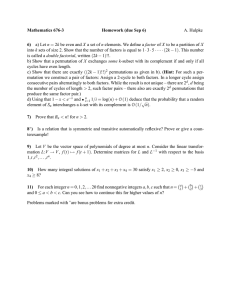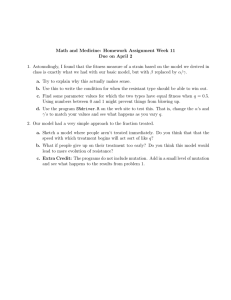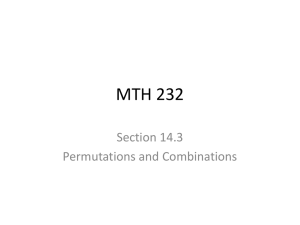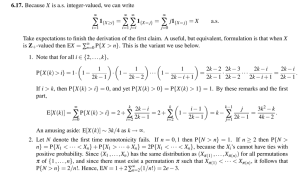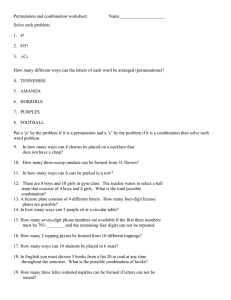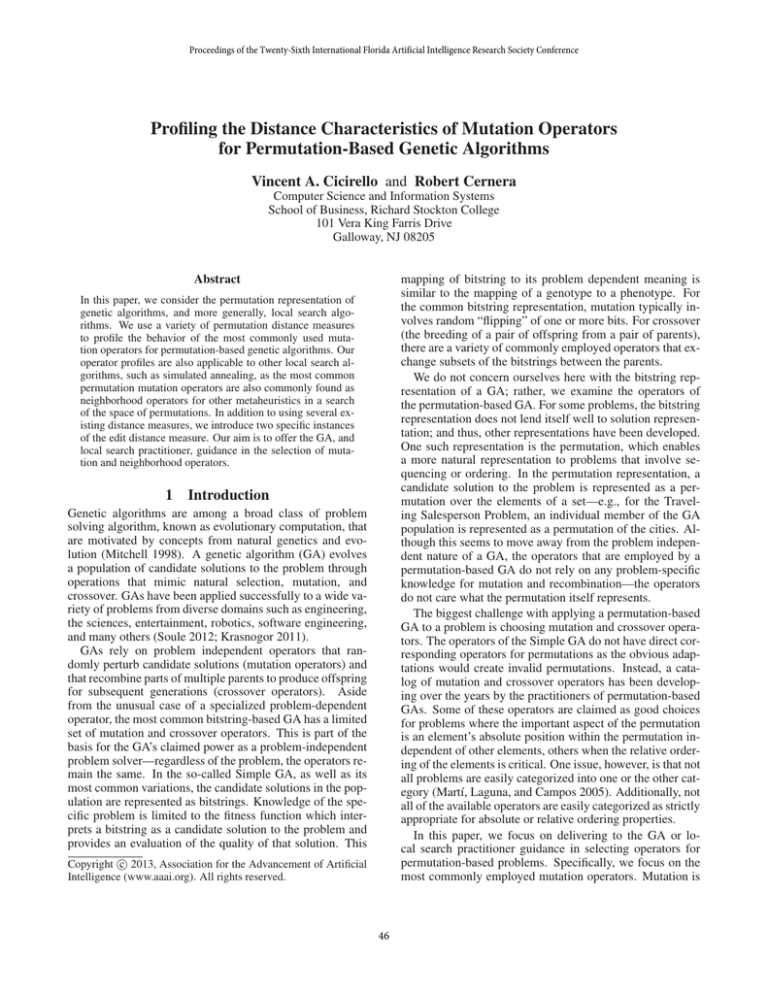
Proceedings of the Twenty-Sixth International Florida Artificial Intelligence Research Society Conference
Profiling the Distance Characteristics of Mutation Operators
for Permutation-Based Genetic Algorithms
Vincent A. Cicirello and Robert Cernera
Computer Science and Information Systems
School of Business, Richard Stockton College
101 Vera King Farris Drive
Galloway, NJ 08205
mapping of bitstring to its problem dependent meaning is
similar to the mapping of a genotype to a phenotype. For
the common bitstring representation, mutation typically involves random “flipping” of one or more bits. For crossover
(the breeding of a pair of offspring from a pair of parents),
there are a variety of commonly employed operators that exchange subsets of the bitstrings between the parents.
We do not concern ourselves here with the bitstring representation of a GA; rather, we examine the operators of
the permutation-based GA. For some problems, the bitstring
representation does not lend itself well to solution representation; and thus, other representations have been developed.
One such representation is the permutation, which enables
a more natural representation to problems that involve sequencing or ordering. In the permutation representation, a
candidate solution to the problem is represented as a permutation over the elements of a set—e.g., for the Traveling Salesperson Problem, an individual member of the GA
population is represented as a permutation of the cities. Although this seems to move away from the problem independent nature of a GA, the operators that are employed by a
permutation-based GA do not rely on any problem-specific
knowledge for mutation and recombination—the operators
do not care what the permutation itself represents.
The biggest challenge with applying a permutation-based
GA to a problem is choosing mutation and crossover operators. The operators of the Simple GA do not have direct corresponding operators for permutations as the obvious adaptations would create invalid permutations. Instead, a catalog of mutation and crossover operators has been developing over the years by the practitioners of permutation-based
GAs. Some of these operators are claimed as good choices
for problems where the important aspect of the permutation
is an element’s absolute position within the permutation independent of other elements, others when the relative ordering of the elements is critical. One issue, however, is that not
all problems are easily categorized into one or the other category (Martı́, Laguna, and Campos 2005). Additionally, not
all of the available operators are easily categorized as strictly
appropriate for absolute or relative ordering properties.
In this paper, we focus on delivering to the GA or local search practitioner guidance in selecting operators for
permutation-based problems. Specifically, we focus on the
most commonly employed mutation operators. Mutation is
Abstract
In this paper, we consider the permutation representation of
genetic algorithms, and more generally, local search algorithms. We use a variety of permutation distance measures
to profile the behavior of the most commonly used mutation operators for permutation-based genetic algorithms. Our
operator profiles are also applicable to other local search algorithms, such as simulated annealing, as the most common
permutation mutation operators are also commonly found as
neighborhood operators for other metaheuristics in a search
of the space of permutations. In addition to using several existing distance measures, we introduce two specific instances
of the edit distance measure. Our aim is to offer the GA, and
local search practitioner, guidance in the selection of mutation and neighborhood operators.
1
Introduction
Genetic algorithms are among a broad class of problem
solving algorithm, known as evolutionary computation, that
are motivated by concepts from natural genetics and evolution (Mitchell 1998). A genetic algorithm (GA) evolves
a population of candidate solutions to the problem through
operations that mimic natural selection, mutation, and
crossover. GAs have been applied successfully to a wide variety of problems from diverse domains such as engineering,
the sciences, entertainment, robotics, software engineering,
and many others (Soule 2012; Krasnogor 2011).
GAs rely on problem independent operators that randomly perturb candidate solutions (mutation operators) and
that recombine parts of multiple parents to produce offspring
for subsequent generations (crossover operators). Aside
from the unusual case of a specialized problem-dependent
operator, the most common bitstring-based GA has a limited
set of mutation and crossover operators. This is part of the
basis for the GA’s claimed power as a problem-independent
problem solver—regardless of the problem, the operators remain the same. In the so-called Simple GA, as well as its
most common variations, the candidate solutions in the population are represented as bitstrings. Knowledge of the specific problem is limited to the fitness function which interprets a bitstring as a candidate solution to the problem and
provides an evaluation of the quality of that solution. This
c 2013, Association for the Advancement of Artificial
Copyright Intelligence (www.aaai.org). All rights reserved.
46
The structure of this conceptual fitness landscape depends
strongly on how we define the neighborhood of a candidate
solution (e.g., (Czogalla and Fink 2009)). What does it mean
for a solution to be “near” another? The shape of the fitness
landscape, therefore, depends upon more than the problem
alone. It also depends upon the operator used for local improvement, which in the case of the GA is the mutation operator. In order to define a relevant fitness landscape that characterizes the problem solving behavior of a GA, one needs
to carefully consider the choice of distance measure.
meant to be a small random perturbation of a member of the
population, relying on the GA assumption (and more generally, the assumption of local search algorithms) that nearby
solutions are of similar fitness. What is a small random perturbation of a permutation? This depends on whether the
problem is what has been termed an “A-permutation problem” or an “R-permutation problem” (Campos, Laguna, and
Martı́ 2005; Martı́, Laguna, and Campos 2005), depending
on whether absolute or relative positioning is most important to the problem. We introduce two distance measures,
Reinsertion Distance and Interchange Distance, for permutations that are instances of the concept of edit distance. Using our distance measures and a variety of other permutation
distances (Ronald 1998; Sörensen 2007) that are available in
the literature, we have developed profiles of the most common mutation operators. As these mutation operators are
also often used as the neighborhood function for other local
search algorithms (e.g., simulated annealing), our operator
profiles are relevant more generally to other permutationbased metaheuristics. Our aim is to offer the GA practitioner
guidance in the design of a permutation-based GA.
Our paper is organized as follows. We begin, in Section 2,
with a discussion of background on fitness landscapes and
existing measures of permutation distance. In Section 3, we
discuss the concept of Edit Distance, and introduce two instances of edit distance that we call Reinsertion Distance and
Interchange Distance. We overview our profiling methodology in Section 4. Next, in Section 5, we present our profiles
of the common mutation operators for permutation-based
GAs. Finally, we wrap-up in Section 6.
2
2.1
2.2
Permutation Distance Measures
We need a mechanism for determining if a permutation operator produces small modifications to a permutation. Thus,
we need to have a notion of distance between permutations.
Many distance measures have been proposed (Ronald 1998;
Sörensen 2007; Shapira and Storer 2007). We have chosen
a set of distance measures that capture the essence of the
so-called “A-Permutation” and “R-Permutation” type problems. In all of the formalization of distance measures that
follow, we use p1 and p2 to refer to permutations, p1 (i)
refers to the element in position i of the permutation, and
N is the length of a permutation.
Absolute Position Based Distance Measures: When profiling the mutation operators, we consider the following distance measures as representative of the characteristics of
problems where “absolute” position within the permutation
is most critical to the permutation’s fitness as a solution:
• Exact Match: The exact match distance (Ronald 1998)
is an extension of the concept of Hamming distance to
permutations. It is the count of the number of positions
containing different elements.
X 1 if p (i) =
6 p2 (i)
1
δ(p1 , p2 ) =
(1)
0 otherwise
Background
Fitness Landscapes
We can conceptualize the space of candidate solutions to an
optimization problem as points on a surface where the height
of the point corresponds to the fitness of that solution. This
surface is known as the fitness landscape (Mitchell 1998),
and likely contains a variety of peaks and valleys which represent local optima. Our optimization problem is to find an
optimal point on that landscape. Local search algorithms
and GAs tend to perform better when fitness landscapes are
smooth with small numbers of local optima; and are especially challenged when faced with a fitness landscape with
plateaus and large numbers of local optima.
GA mutation operators serve the same purpose as a neighborhood operator for a local search algorithm such as simulated annealing—namely, enabling locally improving modifications to a current candidate solution; whereas crossover
operators serve the purpose of escaping from local optima.
An important characteristic of fitness landscapes is
fitness-distance correlation (Jones and Forrest 1995), which
is an application of the Pearson correlation coefficient, used
to measure the correlation between the fitness of a solution
and its distance from the optimal solution. If fitness (i.e.,
solution quality) improves the nearer you are to the optimal
solution (as distance to the optimal solution decreases), then
searching locally (i.e., via mutation) around the current population of solutions will be effective.
i=1...N
• Deviation Distance: Deviation distance (Ronald 1998)
is the normalized sum of the positional deviations of the
elements from one permutation to the other, and is formalized as follows:
1 X
δ(p1 , p2 ) =
|i−j|, where p1 (i) = p2 (j) = e.
N − 1 e∈p
1
(2)
Relative Position Based Distance Measures: We consider the following distance measure as representative of the
characteristics of problems where “relative” position among
the elements of the permutation is most critical to its fitness:
• R-Type Distance: “R-Type” distance (Campos, Laguna,
and Martı́ 2005; Martı́, Laguna, and Campos 2005) was
developed for permutation problems where relative ordering primarily influences solution fitness, and is the count
of the number of adjacent element pairs of p1 that appear
as adjacent element pairs in p2 and can be defined as:
(
N
−1
0 if ∃j, p1 (i) = p2 (j) and
X
p1 (i + 1) = p2 (j + 1)
δ(p1 , p2 ) =
(3)
1 otherwise
i=1
47
Table 1: Pearson correlation, R, between pairs of distance
measure for permutations of length 10. Distances between
all 3628800 permutations of length 10 to a reference permutation were used in computing the coefficients, R.
Exact Match Deviation R-Type
Exact Match
1.000
0.515
0.024
Deviation
0.515
1.000
0.020
R-Type
0.024
0.020
1.000
Table 2: Pearson correlation, R, between the reinsertion and
interchange distances and the other distance measures for
permutations of length 10. For reinsertion distance and interchange distance, R = 0.182.
Reinsertion Interchange
Exact Match
0.301
0.766
Deviation
0.650
0.395
R-Type
0.422
0.009
In selecting a set of distance measures to use in our study,
we wanted to include a representative set of distances that
can be used in characterizing a variety of fitness landscapes.
Using all permutations of length 10 (N = 3628800), we
computed the distances to a reference permutation from the
set. We then examined the Pearson correlation coefficient
for pairs of distance measure. The data is summarized in
Table 1. You will discover that although both Exact Match
and Deviation distance are absolute-position distance measures, they are only moderately correlated (R = 0.515). The
relative position based distance measure, R-Type, is not correlated to either of the absolute-position measures.
distance and each of exact match, deviation distance, and Rtype distance. Reinsertion distance is moderately correlated
to all three, with strongest correlation to deviation distance
(R = 0.65), an absolute-position based measure followed
by R-type (0.422), a relative-position based measure. A single removal/reinsert operation could potentially change the
absolute locations of a large number of elements (all elements in the most extreme case) while retaining their relative ordering, but the resulting permutation would be a distance of only 1 away from its parent. This seems to imply
that this is a relative ordering distance measure. Yet, it is
also possible to create a pair of permutations with almost
identical relative positions, for which this application of edit
distance will give a rather large distance. Consider the permutations: p1 = {1, 2, . . . N/2, N/2 + 1, N/2 + 2, . . . , N }
and p2 = {N/2 + 1, N/2 + 2, . . . , N, 1, 2, . . . N/2}. These
2 permutations are a reinsertion distance apart of N/2, yet
all but one adjacent pair of elements are held in common.
3
Edit Distance for Permutations
Edit distance between two structures (e.g., permutations) is
the minimum cost of the “edit operations” required to transform one structure into the other. The concept originated
in the string pattern matching community (Wagner and Fischer 1974) and is easily extended to permutations (Sörensen
2007). We consider two “edit distance” measures.
3.1
3.2
Interchange Distance
We introduce another edit distance for permutations. The
interchange distance is the minimum number of element by
element interchanges (or swaps) needed to transform one
permutation into the other—by “swap” we refer to general swaps and not strictly adjacent element exchanges. In
Table 2, we demonstrate this to be an absolute-position
based distance measure, correlating most strongly with exact
match (R = 0.766) and moderately correlating with deviation distance (R = 0.395). This is another edit distance.
However, it does not use Wagner and Fischer’s edit distance
operations. Instead, it considers a single edit distance operation, general element interchanges–i.e., swapping the locations of 2 elements within the permutation. This is surprisingly easy to compute. Our algorithm for computing interchange distance is inspired by the permutation crossover operator known as cycle crossover (Oliver, Smith, and Holland
1987), namely on its concept of a “cycle.” Each “cycle” of k
elements in length, contributes k − 1 to the number of interchanges needed to transform one permutation into the other.
Our algorithm computes Interchange distance by finding all
such “cycles.” Pseudocode can be found in Algorithm 1.
Reinsertion Distance
We introduce a permutation distance measure that we
call Reinsertion Distance as the minimum number of removal/reinsertion operations needed to transform one permutation into the other. Edit distance for permutations and
strings (Wagner and Fischer 1974; Sörensen 2007), typically
allows three different operations (element removal, element
insertion, and relabeling an element), although variations exist that include additional operations—e.g., moving or deleting substrings (Shapira and Storer 2007). To apply edit distance, we need to assign costs for each of the 3 operations.
In our Reinsertion Distance, we allow a single type of operation which removes an element and reinserts it someplace
else in the permutation. To compute the minimum number
of removal/reinsertion operations, we use Wagner and Fischer’s dynamic programming algorithm for string edit distance (Wagner and Fischer 1974) where we assign costs of
0.5 for removals, 0.5 for insertions, and ∞ for element replacements. The latter assures us that the edit distance calculation will not consider relabelings. The costs of 0.5 for
each of removals and reinsertions has the effect of counting the minimum number of removal/reinsertion operations
needed to transform one permutation into the other.
This application of edit distance does not neatly fit into either the absolute or relative distance categories. In Table 2,
you will find the correlation coefficient between reinsertion
4
4.1
Profiling Methodology
Permutation Mutation Operators
With the more traditional bitstring-based GA, mutation is almost always limited to a random bit flip—the most obvious
operation to produce a small random perturbation of a bitstring. With the permutation representation, the choice of
48
Algorithm 1 Interchange Distance
Input: X = {x1 , x2 , . . . , xN }, Y = {y1 , y2 , . . . , yN }
Output: δ(X, Y ) = minimum number of swaps to transform permutation X to Y
D←0
elements ← {e|e ∈ X}
while elements 6= ∅ do
cycle ← ∅
current ← any member of the set elements
i ← IndexOf(current, X)
while current ∈
/ cycle do
cycle ← cycle ∪ {current}
current ← Y (i)
i ← IndexOf(current, X)
end while
D ← D + |cycle| − 1
elements ← elements − cycle
end while
return D
. D = δ(X, Y )
Exact Match Distance
16
4
16
32
64 128 256 512 1024
Permutation Length
Figure 1: Average Exact Match Distance between parent and
child permutations produced by 1 random mutation.
(Figure 1) and Deviation Distance (Figure 2). In Figure 1,
we see that a single swap mutation produces a child that is
a constant exact match distance of 2 from its parent, independent of permutation length. All other mutation operators
produce children that are approximately an exact match distance of N/3 from the parents. In Figure 2, we see that both
Scramble and Reversal are disruptive under deviation distance, producing children that are unlike the parents, especially for larger permutations. However, both the Insertion
and Swap operators make very small changes to the parent
permutations. The average deviation distance between parent and child for both of these operators is around 0.67, independent of permutation length.
For so-called “A-permutation” problems, Swap mutation
should be preferred as it produces small perturbations of the
candidate permutation, independent of which absolute position based distance measure we consider. However, Insertion mutation should not be overlooked as a candidate
operator for these problems as well. The exact match distance simply fails to recognize the small positional movement made to those elements that are shifted, while deviation distance captures that behavior. The Scramble and the
Reversal operators are very disruptive with respect to “Apermutation” problems. However, as such, they might be
useful to other local search algorithms to “kick” the search
out of a local optima.
We now profile the operators for relative position based
distances, namely for the R-Type distance measure (see Figure 3). For the Scramble and Reversal operators, distances
increase linearly with the length of the permutation. Insertion mutation consistently produces children on average a
smaller distance from the parents as compared to swap—
average distances of 3 and 4, respectively, independent of
permutation length. Both operators are reasonable choices
Generating Profiling Data
Our process for generating the data used to profile the mutation operators is as follows. We consider the following
permutation lengths: {16, 32, 64, 128, 256, 512, 1024}. For
each permutation length, and for each combination of mutation operator and distance measure, we generated 10000
random parent permutations and created a child of each via
one random mutation. Therefore, in the profiles that follow,
each point on each graph is the average distance between the
parent and child of 10000 random mutations.
5
64
1
operator is not as obvious. Here, we consider the most common choices of mutation operator for permutation-based
GAs. Our aim is to shed light on when their behavior can
be considered to produce small random perturbations. The
mutation operators that we profile are as follows:
• Insertion: Insertion mutation removes one randomly selected element from the permutation, and reinserts it into
a different randomly selected position.
• Swap: Swap mutation exchanges the positions of 2 randomly selected elements from the permutation. All other
elements remain in their current positions.
• Scramble: Scramble mutation selects 2 different random
indices, and then randomly shuffles all elements between
the 2 indices, inclusive, with all possible reorderings of
the selected region equally likely.
• Reversal: Reversal mutation selects 2 different random
indices, and reverses the selected sub-permutation.
These are the most common permutation mutation operators
and are also widely used as neighborhood operators for other
local search algorithms (Serpell and Smith 2010; Cicirello
2006; 2007; Valenzuela 2001).
4.2
Insertion
Swap
Scramble
Reversal
256
Mutation Operator Distance Profiles
We first profile the mutation operators from the perspective
of the absolute distance measures, Exact Match Distance
49
Insertion
Swap
Scramble
Reversal
Insertion
Swap
Scramble
Reversal
256
64
R-Type Distance
Deviation Distance
256
16
4
1
64
16
4
1
16
32
64 128 256 512 1024
Permutation Length
16
Figure 2: Average Deviation Distance between parent and
child permutations produced by 1 random mutation.
32
64 128 256 512 1024
Permutation Length
Figure 3: Average R-Type Distance between parent and
child permutations produced by 1 random mutation.
for “R-permutation” problems, but in terms of consistent
lower distance which implies the smaller random perturbation that mutation operators are meant to provide, insertion
mutation is superior to swap. Again, the scramble and reversal operators may be applicable to local search algorithms to
“kick” the search out of a locally optimal solution.
In Figure 4, we profile the mutation operators for the
Reinsertion Distance. Recall that this edit distance measure
is defined as the minimum number of removal/reinsertion
operations needed to transform (or edit) one permutation to
the other. Thus, the average distance of a child produced
via the reinsertion mutation operator is a constant distance
of 1 from its parent. Thus, reinsertion mutation is an ideal
candidate for permutation problems whose fitness landscape
can be characterized by this distance measure. Swap mutation produces children whose average distance from the
parents approaches 2 with increasing permutation length.
Thus, swap mutation is also a reasonable candidate. The
average distances produced by Scramble and Reversal mutations grow linearly with permutation length, and are thus
too disruptive to serve as an effective GA mutation operator.
In Figure 5, we profile the mutation operators for Interchange Distance. Recall that this is another edit distance.
However, unlike Reinsertion Distance, the Interchange Distance is primarily an absolute position based distance measure. Like the other absolute position based measures, we
find that the swap operator stands out from the others, consistently producing children a distance of 1 from the parents,
independent of permutation length. Though recall that this
measure is defined as the minimum interchanges needed to
transform one permutation into the other. As the swap mutation randomly exchanges the positions of 2 elements, by
definition only 1 interchange is needed to undo that operation.
6
Conclusions
We have profiled the most common mutation operators for
the permutation representation of a GA. These operators are
also commonly used as local neighborhood operators for
other local search algorithms such as simulated annealing
when searching the space of permutations. Thus, our results
are generally applicable to metaheuristics beyond the GA.
We have found that for “A-permutation” problems, where
absolute position within the permutation is most indicative
of solution fitness, that the Swap mutation operator is the
most applicable. Regardless of which absolute distance
measure we consider (Exact Match, Deviation Distance, or
Interchange Distance), the swap operator produces a small
random change to the permutation, which is the essence of
what mutation is meant to be. Depending upon which specific absolute distance measure leads to the “friendliest” fitness landscape (smoother landscape, less local optimas, etc)
for the problem we are solving, we may also consider Insertion mutation (see analysis of deviation distance).
For “R-permutation” problems where relative positioning
within the permutation has the biggest impact on solution fitness, we have found that Insertion mutation, as well as Swap
mutation, produces the smallest random changes to the candidate solutions, and are thus likely to be the most effective
choices as mutation operator. Insertion mutation also has
proven to be the best choice for problems where the edit distance known as Reinsertion Distance leads to a promising
fitness landscape for local improvement algorithms.
Although Scramble mutation, and in most cases Reversal
mutation, appear too disruptive to be effective mutators, our
profiles can be used to argue that they can be effectively used
within a local search algorithm to “kick” the search out of
local optimas to prevent or mitigate search stagnation.
50
Insertion
Swap
Scramble
Reversal
Insertion
Swap
Scramble
Reversal
256
Interchange Distance
Reinsertion Distance
256
64
16
4
1
64
16
4
1
16
32
64 128 256 512 1024
Permutation Length
16
32
64 128 256 512 1024
Permutation Length
Figure 4: Average Reinsertion Distance between parent and
child permutations produced by 1 random mutation.
Figure 5: Average Interchange Distance between parent and
child permutations produced by 1 random mutation.
Acknowledgments
vs. genetic algorithms: An experimental evaluation with permutation problems. In Metaheuristic Optimization via Memory and Evolution. Springer. 263–282.
Mitchell, M. 1998. An Introduction to Genetic Algorithms.
MIT Press.
Oliver, I.; Smith, D. J.; and Holland, J. R. C. 1987. A study
of permutation crossover operators on the traveling salesman problem. In Proceedings of the Second International
Conference on Genetic Algorithms, 224–230.
Ronald, S. 1998. More distance functions for order-based
encodings. In Proceedings of the IEEE Conference on Evolutionary Computation, 558–563. IEEE Press.
Serpell, M., and Smith, J. E. 2010. Self-adaptation of
mutation operator and probability for permutation representations in genetic algorithms. Evolutionary Computation
18(3):491–514.
Shapira, D., and Storer, J. A. 2007. Edit distance with move
operations. Journal of Discrete Algorithms 5(2):380–392.
Sörensen, K. 2007. Distance measures based on the edit
distance for permutation-type representations. Journal of
Heuristics 13(1):35–47.
Soule, T., ed. 2012. GECCO ’12: Proceedings of the
14th International Conference on Genetic and Evolutionary
Computation. ACM.
Valenzuela, C. L. 2001. A study of permutation operators for
minimum span frequency assignment using an order based
representation. Journal of Heuristics 7(1):5–21.
Wagner, R. A., and Fischer, M. J. 1974. The string-to-string
correction problem. Journal of the Association for Computing Machinery 21(1):168–173.
This work was supported by the National Science Foundation under grant DUE-1059934. Any opinions, findings, and
conclusions or recommendations expressed in this material
are those of the authors and do not necessarily reflect the
views of the National Science Foundation.
References
Campos, V.; Laguna, M.; and Martı́, R. 2005. Contextindependent scatter and tabu search for permutation problems. INFORMS Journal on Computing 17(1):111–122.
Cicirello, V. A. 2006. Non-wrapping order crossover: An order preserving crossover operator that respects absolute position. In M. Keijzer et al., ed., Proceedings of the Genetic
and Evolutionary Computation Conference (GECCO’06),
volume 2, 1125–1131. ACM Press.
Cicirello, V. A. 2007. On the design of an adaptive simulated annealing algorithm. In International Conference on
Principles and Practice of Constraint Programming: First
Workshop on Autonomous Search. AAAI Press.
Czogalla, J., and Fink, A. 2009. Fitness landscape analysis for the resource constrained project scheduling problem.
In Stützle, T., ed., Learning and Intelligent Optimization.
Springer-Verlag. 104–118.
Jones, T., and Forrest, S. 1995. Fitness distance correlation
as a measure of problem difficulty for genetic algorithms. In
Proceedings of the 6th International Conference on Genetic
Algorithms, 184–192. Morgan Kaufmann Publishers Inc.
Krasnogor, N., ed. 2011. GECCO ’11: Proceedings of the
13th International Conference on Genetic and Evolutionary
Computation. ACM.
Martı́, R.; Laguna, M.; and Campos, V. 2005. Scatter search
51


